“Bliss is working out freely, doing lots of cartwheels and waking up the next day with pain-free wrists.” -Me
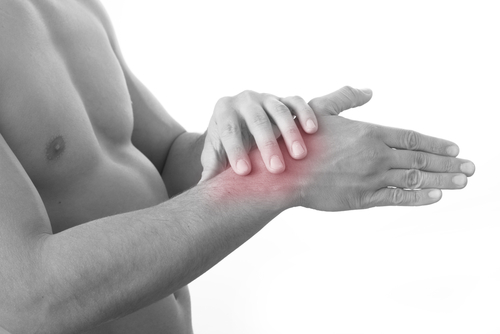
When it comes to bodyweight exercises or floreio movements, we end up spending lots of time on our hands and feet. Our wrists weren’t built to deal with the entire weight of our body the same way our ankles were. As a result, we may end up with sore wrists, or worse, a sprained wrist which indicates that the connective tissue is damaged.
In this post, I will try to tackle this issue the best I can so that you get a much more intimate understanding of how to deal with it so you do not repeat the same mistakes I did.
Assessment, basic tips and the importance of REST
Is it a sprain or worse? Go see a doctor if any of the following are being experienced
Jarlo, the physical therapist of GoldMedalBodies has written a helpful article on helping you understand if this is something you could manage on your own or see a doctor.
If you experience any of the following symptoms, go to a doctor:
- numbness/tingling,
- significant weakness not related to pain,
- pain that wakes you up at night,
- sharp, shooting pain that goes down your arms or legs,
- any pain that doesn’t improve significantly within a week and pain of greater than 5 on a 1-10 scale.
Also, here is a “Wrist Pain Decision Guide” by the Harvard Medical Site. Answer the questions and it will help verify that you indeed, have a sprain, or something else.
Update: Harvard removed their wrist pain decision guide, but I found it here on web.archive.org. Hopefully that works.
If it is indeed a sprain, the prognosis is EXCELLENT if you allow your wrist to REST.
This is especially true for people who do not exercise or play sports that use the wrist. So listen, unless you’re getting paid big sums of money to be an athlete and you have to do it to support your family, then there is absolutely no reason to risk injuring your wrist again. You have all the time in the world to heal. If you are impatient and aggravate your condition again, you will delay the healing process even further.
Stretching is not the answer
If tendons or ligaments are damaged, stretching isn’t going to heal it. And to make matters worse, by stretching a joint, we risk sacrificing stability even further.
So nowadays, I only do extra wrist stretches as needed. Now, with that said, if you feel your wrists are genuinely tight, I really enjoyed this wrist warmup/stretching video and I have made a couple wrist stretching videos that you may enjoy. But don’t do these if your wrist is sprained at the moment as it will probably hurt!
The wrist is mostly just bones and connective tissue and it’s going to heal slower than muscle
Look at the arm in the middle below. Around the wrist, you see it’s white. That’s because there are no muscles there. The muscle bellies that control your wrist movements are found proximal to your wrist (closer to your elbow). Those muscles cross over the wrist joints and onto the hand through tendons and the wrist is full of an intricate array of ligaments. When you have a sprain in the wrist, it’s these ligaments and tendons that need healing, and their metabolic rate is 7-10x slower than muscle tissue due to their lack of vascularization (networks of blood vessels). What would take muscle tissue just one day to heal, would take connective tissue 7-10 days to heal. You cannot speed up this process through magic. This is why it is imperative you do not aggravate your condition further by “pushing through the pain” or anything silly like that. Heed the pain signals your body is giving you.
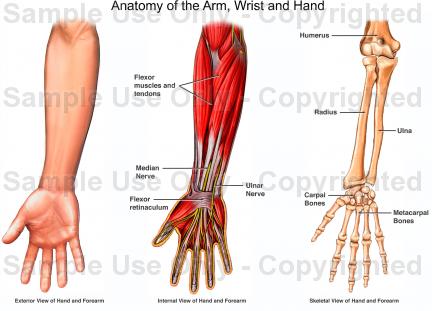
Don’t worry, your wrists will not only heal, but be stronger than before!
When I had sprained my wrist, I met another guy who had a sprained wrist as well, and I was like, “Oh man that sucks!” And he actually replied with, “No it doesn’t suck.” I was bewildered and I asked why. He said because he was now taking care of it, letting it heal and doing wrist exercises, and as a result of all this, it’s actually going to end up being stronger than it ever was before!
That got me looking up. And he was right, both our wrists are effin’ fine now. I was demoralized, depressed that I couldn’t workout and I was (irrationally) thinking I was screwed for life. He got me to realize that things were not only going to be all right, but better than all right. All it takes is patience and compliance with your rehab.
Drop the Ego and REST. You’re not going to lose your gains.
When I started to finally stick a handstand… I ended up trying handstands way too often without warming up and sprained my wrist. And then I started to cry inside thinking I was going to lose my [handstand] gains. I got antsy and wanted to train it so bad.
But then it hit me. It took me about ~6 months to be able to hold a handstand for just barely a few seconds. And most of that was not strength related but more-so about coordination, balance and understanding how to hold tension in the right spots. So, if I let my wrists heal completely, and I mean COMPLETELY, then I could probably continue where I left off pretty fast.
And besides, I hadn’t even practiced handstands for the first 29 years of my life. Why was I scared that I was going to fall apart into a skinny-fat individual from 3-4 weeks of off-time? This stuff sounds ridiculous when you think about how much the ego wants to show off. Tell it to shut up.
- No more surfing. (An explosive push up? Basically asking for the wrist to hurt again!)
- No more … you know what.
Don’t be depressed, you’re not going to be fucked for the rest of your life.
You’re not going to be crippled forever just cause of this sprain, so stop worrying about that. But what will make you lose a lot is if you become impatient, try working out before it’s healed, fuck your wrist up all over again, and then instead of waiting 2-4 weeks, you end up waiting months.
Take a strong mental note of what you did that caused your wrist to hurt so you don’t make the same mistake again.
- For me, the first thing that caused a sprain was holding an L-sit on a 2″ slackline.
- The next time, it was from doing wrist-to-fist push ups. Ironically, this is an exercise that I was doing for strengthening my wrists. I had been doing them on my knees without any problems. I tried to do one rep in plank position just to see if I could and I hurt my wrist.
- After that was healed, I was starting to get better at handstands. Once I started to stick the freestanding version, I got hooked to trying handstands more often. And then my wrists started to feel great pain.
I am telling you these things because I don’t want you to make the same mistakes. I will stick to wrist-to-fist push ups on my knees for a very long time. I will never just jump into a handstand anymore without thoroughly warming up my wrists so they have better range of motion. If I didn’t take mental note of these things, I could very easily make the same mistakes again. (Our memory sucks!)
How long does it take to recover from a sprain?
Your recovery depends on the severity of your sprain and how good you are about not aggravating your condition further. I’ve had it range anywhere from 5 days to 4 weeks.
I remember the first time I sprained my wrist, it got 90% better after 2 weeks, but then I wasn’t patient enough to let it heal up completely, and I tried working out and messed it up and had to wait an extra 2-3 weeks all over again. So that sucked. I also was a total noob and didn’t know the things I know now, which is why this post is so lengthy.
Stop using your injured wrist for even the smallest things that hurt!
You may think that opening a door with your injured wrist may not be a big deal since it only hurts for just a fraction of a second, but all moments add up! Completely abstaining from using my wrist in even the tiniest ways was crucial to my recovery. For example:
- I started opening doors only with my non-injured hand.
- I put on my seat belt only with my non-injured hand.
- I turned the steering wheel only with my non-injured hand.
- I cooked and chopped food only with my non-injured hand.
- I did everything with my non-injured arm.
- If it hurts even a little, don’t do it!
How to deal with depression and staying active
Experiencing depression from not working out?
I was addicted to being active. And because I couldn’t do my regular routine, I started to experience withdrawal symptoms: Anxiety, depression and I couldn’t sleep well. I was scared all my progress was going to be undone. Exercise was my drug, my outlet, and the injury made me realize how hooked I really was to the post-workout endorphins. I thought I was going to be forever handicapped. The wrist wasn’t getting better in the first week. I was so scared. I thought I wasn’t going to be able to go on the rings anymore. That was the end of my life. All these stupid thoughts. Quite the depression. I remember the morning when I lifted my arm and didn’t feel the pain, that it was like a Christmas miracle.
But… you could still workout if you want to!
Remember that your wrists are only a small part of your body. You still have your legs. So you need to find things to do that don’t involve the wrists. For example, I created a wrist-friendly workout routine. So I was basically working my legs and core a lot. In that routine I even found a way to do “no arm” pull ups as well using ab straps. Being able to workout made me feel a lot better psychologically. And I’d like to think that the exercise helps to create an anabolic response which in turn also helps the arms heal as well. (Think of how catabolism is a prerequisite for anabolism.)
I almost forgot to mention, that I got really good at slacklining as well during this time… since slacklining doesn’t require any hands! If you want to try slacklining, I must tell you, it’s very challenging and took me a while just to be able to walk on it comfortably. But it’s a great exercise for your mind and body. I recommend the YogaSlackers line for beginners. It feels very forgiving and has a really nice feel to it.
By January 2014 I tried my hand at hooping on the slackline and succeeded…
Still Bored? Work on your [hip] flexibility
Stretching your hamstrings, glutes and hip-flexors doesn’t require you to use your wrists, so why not work on your splits? I have an ongoing 90-day splits challenge hosted at /r/flexibility and it’s really awesome! Practicing for the splits will keep you busy, be quite intense in terms of how much power it requires and help make you feel great after a full session!
The magic of contrast baths and various wrist braces
Contrast bath hydrotherapy is really awesome!
Contrast baths work extremely well for the wrists (and can be used for ankles as well if one has ankle problems).
Note: Don’t do this in the first 72 hours of a fresh injury.
- Get two buckets or big pots. (Anything that allows you submerge your hand and wrist completely. If you can’t find anything, you could even plug up your kitchen sinks and fill them with water.)
- Fill one with water and ice.
- Fill the other one with hot water. Test it out to make sure it’s not going to burn you. (This is the only part of this therapy that you may hurt yourself with, so let’s avoid burning your hand with scalding water, yes?)
- Put your entire hand and wrist into the cold water for 1-2 minutes.
- Then in the hot water for 1-2 minutes. (Coming from the cold, it may feel like it’s burning your skin, but it’s not because you tested it already, remember?)
- Keep alternating back and forth like this for 15-20 minutes.
- End with the cold water.
ProTip: When your hand is in the hot water, carefully stretch each finger back and move your wrist around slowy in the hot water. Stretch the fingers back and you’ll feel the fascia release of your hand. Don’t do this in the cold water.
Why this works? The cold causes vasoconstriction (narrowing of the blood vessels), causing the blood (and swelling/excessive inflammation) to leave. The hot water causes vasodilation (widening of the vessels) which allows the blood to rush back in with greater perfusion each time. So when you keep alternating like this, it acts like a pump. You’re basically exaggerating the effect that icing an injury has by accelerating the process.
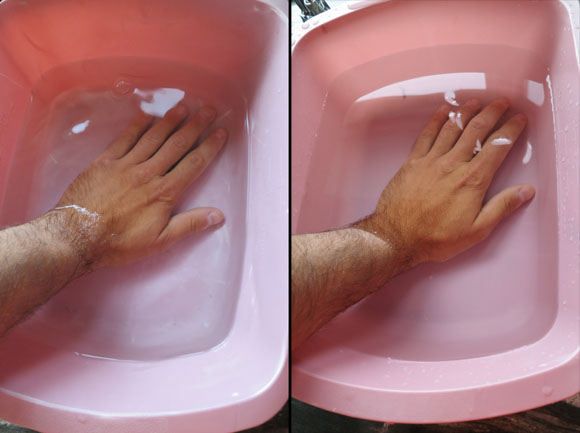
Wearing a brace is a great idea, especially if you HAVE to use your hand, like when cooking.
The brace helps limit the range of motion of your wrist, and it also acts as a good reminder to not use that hand. Note that if your hand feels cold with the brace on, it’s likely on too tight and restricting blood flow.


If your sprain isn’t that bad, this compression brace feels amazing
This compression sleeve feels good. Really good. The compression is supposed to reduce the swelling/inflammation which helps with the circulation. It feels like it’s just hugging the wrist and while I didn’t think there was any swelling to begin with, I would wear this at night and wake up with my wrists feeling better. I especially like to wear it on that last week where I know I’m almost healed up but don’t need a hardcore support brace.
If you want a support brace that doesn’t interfere with your grip, these Skids Wraps are awesome!
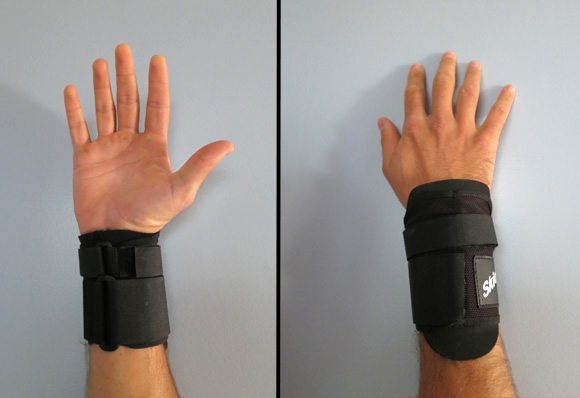
These skids wraps stabilize your wrist and prevent you from going into painful ranges without interfering with your grip. With it, you could hold on to a bar or rings with a standard grip (sorry, no false grip). You could do yoga on the floor or whatever else and feel protected. But again, remember, this is not an invitation for you to use your wrists before they are fully healed. You should only attempt to use your wrists for heavier things when it feels healed up. Chronic pain is not something you want to deal with just because you kept preventing yourself from healing completely.
More tips your doctor may not to tell you!
If you’re on a fat-loss diet, eat at ‘maintenance’ until you’re injury free.
Everything I read says that you have to eat at maintenance when you’re injured, meaning, don’t eat a deficit. I thought I was going to explode with fatness and lose all my muscles if I ate more. But that’s BULL SHIT. Body composition isn’t going to change just because you’re going to be eating the amount your body actually needs for a couple weeks. Besides, eating at a deficit accelerates muscle catabolism with the absence of strength training, so EAT and you won’t lose much strength.
Get an actual 7-9 hours of sleep (try sleeping early)
Sleep is when our body can focus on repairing itself. If we are depriving ourselves from sleep, we are shooting ourselves in the foot. I know you think you’re badass because you think you’re operating at 100% on less than six hours of sleep, but you’re probably not. Only 1-3% of the population has the gene that allows them to get by with 6 hours or less of sleep and functioning at their best. (You may be walking around impaired without even knowing it.) And by the way, if you’re working out, something closer to 9-10 hours (not just 7-9) is better for recovery.
I started getting more sleep in (a solid 8-9 hours) by simply sleeping earlier. I wasn’t doing anything productive on the late nights anyway. I also started squeezing in a solid 1.5 hour nap during the day if I felt like I needed it. If you have trouble sleeping, there’s something called melatonin that is available over the counter as a sleep aid.
Try these Novel Wrist Movements
Pain is a funny thing. Sometimes our brain gets used to feeling pain… to the point of expecting pain even when the nociceptors (pain receptors) are not firing. Much of the most powerful manual therapy involves simply reminding the body that it can actively achieve ranges of motion beyond the limits of typical holding patterns. The following “novel” wrist movements help remind you of what it’s like to move your fingers and wrist without pain so your brain gets the signal that things might be okay after all.
Self Massage your Forearms
I’m a huge fan of self-massage. I tout foam rollers and lacrosse balls all the time. And in the video below, I show how you could self-massage your forearms without any equipment! The muscles that control your wrists and fingers are all bunched up in your forearms, and so this may help alleviate some tension downstream!
What to do when the pain is gone and how to go back to training safely
Pain Gone? Wait one more week before jumping in to your normal routine.
So maybe you did the hot/cold contrast bath last night and woke up this morning with zero wrist pain? Well, that’s an amazing feeling. But that doesn’t mean you’re ready to jump on your hands. Once you are 100% pain-free, wait one more week. This one in particularly hard to chew but it makes a lot of sense. Keep your eye on the prize (100% recovery) and keep being very careful with your wrist until that extra week has passed.
You waited? Good, now make it a habit to always warm up your wrists with this video
No matter if you’re going to do push ups or yoga or anything wrist related, warm them up using the video below. Make it a ritual to go through this sequence. It really is that good. Your wrists will be stronger and more flexible because of it. And as always, if any of the motions hurt, skip those particular ones and heed that as a warning sign that you’re not completely healed up. If you’re pain-free, I recommend you do this sequence everyday, actually!
After you watch the video a couple times, you can just write down this “cheat sheet” below and always have it by your side for reference until you memorize it!
- Finger Pulses
- Palm Pulses
- Side to Side Palm Rotations
- Front Facing Elbow Rotations
- Side to Side Wrist stretch (lean/push away)
- Rear Facing Wrist stretch – palms down
- Rear Facing Wrist stretch – palms up
- Rear Facing Elbow Rotations (star trek vulcan salute)
- Forward Facing, Lean Forward as much as possible
Warmed them up? Good! But don’t jump back into your normal routine as hard as you used to.
You are not an on/off switch! If you lift weights, start with a lighter weight. If you do bodyweight exercises, test your wrists with the easier progression of an exercise.
For example, if your goal is to do push ups…
- Try push ups on your knees and see if that hurts your wrist.
- If that’s okay, then try some inclined push ups and see if your wrists are okay with the pressure.
- If that’s okay then move onto normal push ups. If you felt pain again at any of the steps, that’s a red flag to not increase the intensity, cause that may be detrimental to the healing process.
- If you got to normal push ups and you didn’t feel any pain, GREAT! Plus, those earlier progressions acted as a great warm-up to get the blood flowing anyway, so they’re totally worth doing.
There’s plenty of time (a whole lifetime, actually) for you to gain your strength back. Don’t fuck things up and aggravate your condition, unraveling all your progress just because you went too hard, too fast. “No pain, no gain” doesn’t apply to joints and is a recipe for chronic pain if you’re injured.
If anything causes the slightest bit of pain, forgo that exercise for now.
Write down (or take strong mental note) which exercise hurts as you go through your workout. For example, I found that pull ups didn’t hurt but chin ups did. I also experienced pain when I went into the RTO Support Hold. So I didn’t do chin ups, support holds (or ring dips and muscle ups) to not risk screwing anything up. I waited a few more days before trying those exercises again and sure enough, they were fine a few days later. You’re not gonna melt and lose your gains or develop muscle imbalances in the meantime.
Avoid dumping all the weight in your wrists
Avoid putting all your weight in the heel of your hand!
This infographic by Candace helps you understand how to properly distribute the weight on your hands.
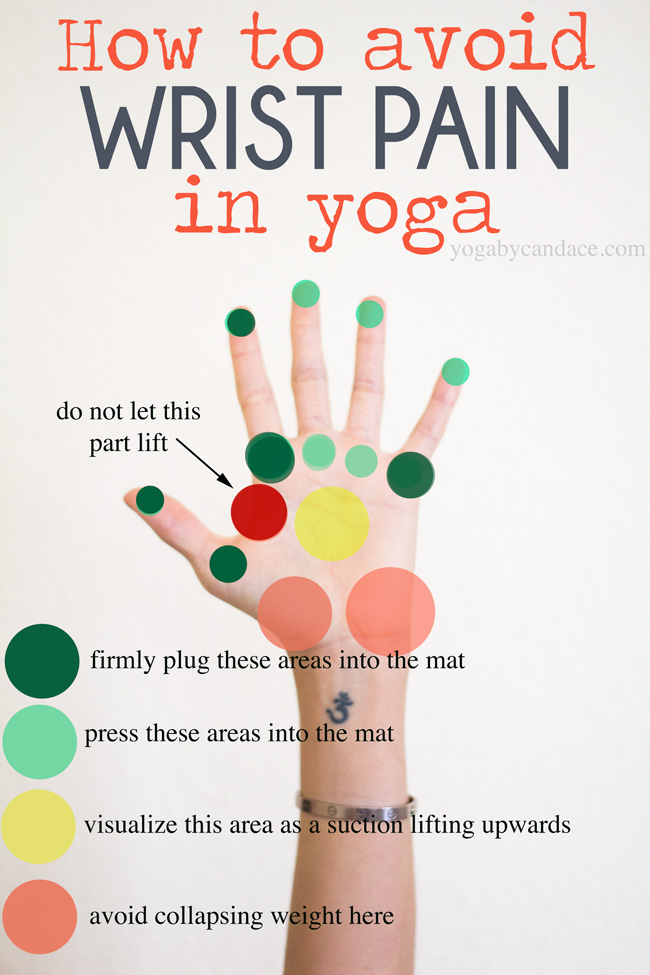
Experiment with these wrist positions on the floor
To take this concept of not collapsing weight into the heel of your hand to the extreme, if you put your thumb back, your wrist lifts off. This requires some flexibility and finger strength, but it’s a nice stretch in itself and actually feels good since it puts the wrist into a completely neutral position. If I need to stay on my wrists during a yoga class for a long time and my wrist feels funky, I will often do this.

Make it a habit to grip the floor with your fingers (cambered hand technique)
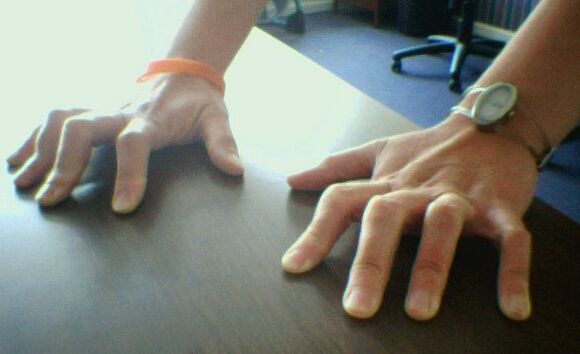
- I originally learned this “cambered hand technique” from Chris Salvato as a powerful tip for hand-balancing. The power of your fingers are not to be ignored.
- Emmet Louis shows you how pulling the fingers back allows you to exert tons of power. (Bonus: Another video of his demonstrates the handstand drill known as heel pulls that shows the power your fingers have to help you rebalance when your feet go too far forward.)
- In this video by Esther Ekhart on how to protect your wrists, she explains the importance of gripping the floor with your fingers. She mentions how if you’re on your hands and someone is able to easily lift your finger, then that’s a sign most of the pressure is likely in the heel of your hand.
Consider using parallel bars or parallettes to alleviate wrist pressure for your hand-balancing
If you have a practice that includes frog stands, handstands, planches and so forth, then all your weight is going on your wrists. Unfortunately it’s very common for the wrists to give out before the other body parts in handstand practice. But if you use parallettes, it will help alleviate the pressure off your wrists because your wrist will be in a neutral position and not extended. It’s akin to doing push ups on your fists rather than on your palms. (A lot of people mention plank/push ups on their fists don’t hurt when their wrist is sprained.)
Be cautious when hanging off tree branches, ledges, stairs, and thick poles
There’s not much to say here other than these “non standard” structures can really screw your wrists up if they’re not ready to handle the demands since the grip is unusual.
Want to ride your bicycle? Here are some tips…
I found that my wrist always felt better after riding my bicycle. My best guess would be the increased blood flow is why it felt that way. However, I did have to make some modifications such as…
When you’re riding your bicycle, don’t grip the handlebar with all your might. If you grip it really hard, as you’re bopping up and down, you will aggravate the wrist. Also, avoid climbing mountains/hilly routes if that’s going to require you to grip hard to help your lower body generate more power.
If you could ride with one hand on the bar safely, with your injured arm dangling and not holding anything, that feels good too. It also helps to wear your wrist brace while bicycling.
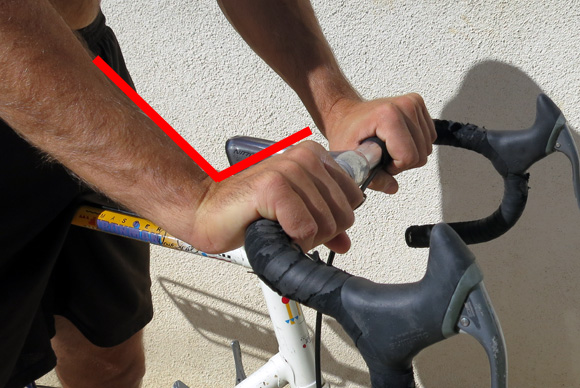

Want to do yoga? Here are some tips…
First of all, don’t do yoga unless you’re totally healed up, because yoga is often very intense on the hands. But if you’re pain free and want to stay pain free, here are some ways to modify your practice.
Skip the vinyasa if you’re sensitive. In some classes, they’ll instruct you to repeatedly go through a vinyasa flow (Plank, lower down, updog, downward dog, etc) and repeat it over and over and over. These repetitive motions may put a lot of pressure on your wrist, especially if there’s a lot of speed to it! So if you’re in yoga class, just chill in childs pose. Or if you want to be challenged, go in downward dog on your forearms.

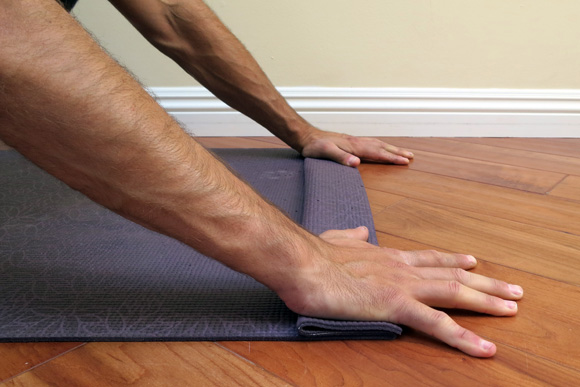
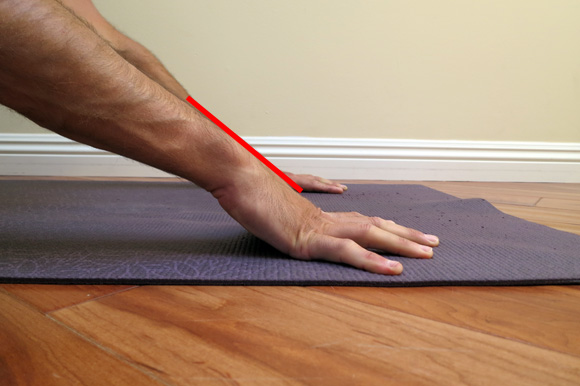
So to sum up…
- If your wrist is sprained, REST.
- If you must exercise, do exercises that don’t involve the wrists.
- Do those hot/cold contrast baths 72 hours after a sprain.
- When you’re pain free, wait another week to be on the safe side!
- Warm up and stretch your wrists with this video by GMB.
- Strengthen them with palm pulses and back of hand pushup progressions.
- Maintain a workout log. If your wrist pain ever comes back, you can often track it to a specific exercise.
I hope that was helpful. And remember, don’t be depressed. I experienced a lot of wrist issues in the past year but I don’t anymore and at least now you are equipped with the knowledge you need to get through this. Plus, a lot of experienced people mention that their wrists used to get sore when they started doing handstands but that it doesn’t any more as well. So don’t worry, with time, patience and properly warming up, sprains will become a thing of the past! And if your condition isn’t improving, go see a doctor!







